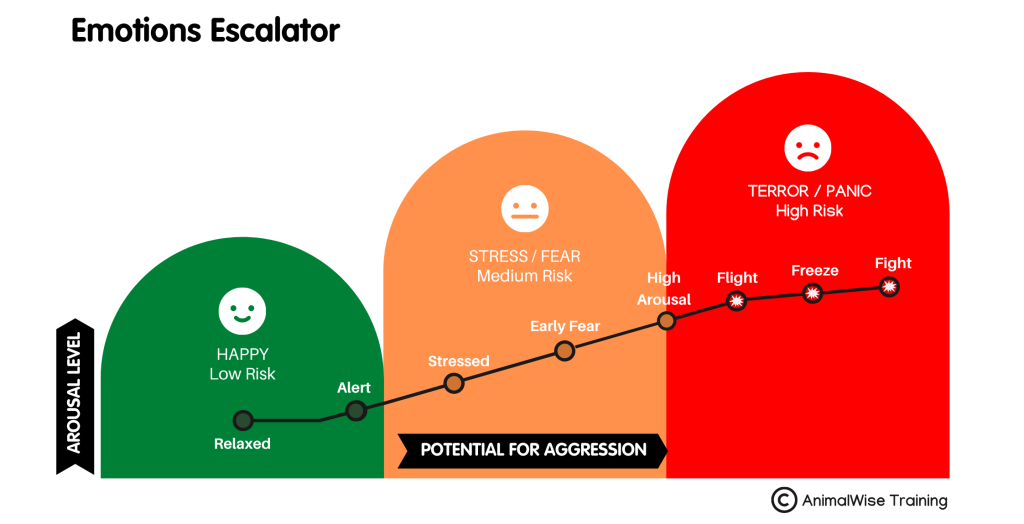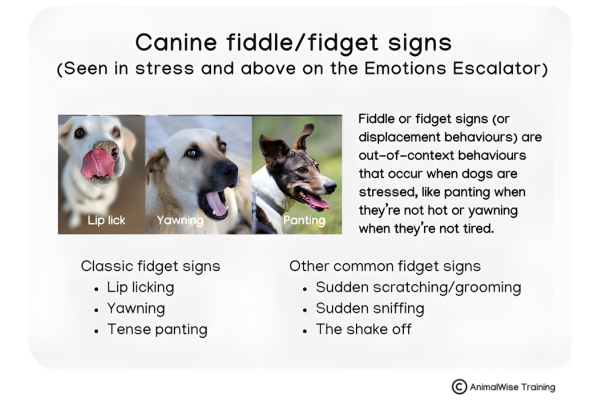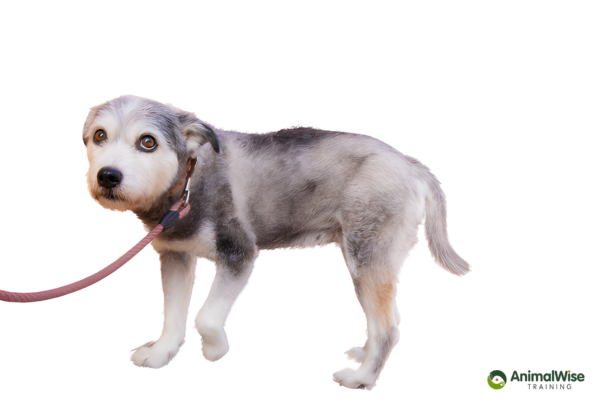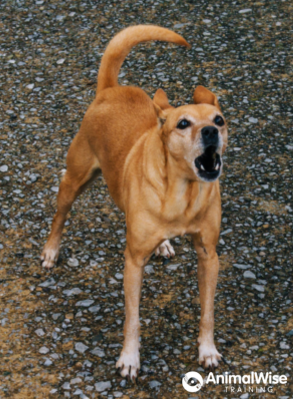For animal professionals, understanding canine communication isn’t optional; it’s a core professional skill.

For those of us working with dogs every day—vets, doggy daycare attendants, groomers, trainers, shelter staff, rangers—understanding canine communication isn’t optional. It’s a core professional skill.
Dogs may not speak our language, but they are constantly communicating with us through body language and subtle signals. Every ear flick, posture shift, and change in facial expression offers clues about how a dog feels, their arousal level, and potential risk for aggression.
Accurately interpreting these signs and responding appropriately can mean the difference between a safe interaction and one that escalates into danger.
More Than Just Signals
Dogs have hundreds of body language cues: posture, facial expression, gait, muscle tone, ear position, and more. Taken alone, each sign may tell us very little. However, when assessed within a structured framework that includes the context and environment, these cues combine into a clear picture of the dog’s emotional state and the likelihood of escalation.
This is why reading body language must always be approached as an ongoing and dynamic risk assessment, not just an observational exercise. One practical tool to help with this process is the “Emotions Escalator” Framework.
The “Emotions Escalator” Framework
A practical and visual way to conceptualise dog bite risk is through the Emotions Escalator.

On the vertical axis is the dog’s emotional arousal level, and on the horizontal axis is their potential for aggression. The important relationship we see, is that as the dog’s arousal level increases, so too does their potential for aggression.
Dogs move up and down the Emotions Escalator depending on their level of stress, arousal, frustration and perceived threat.
The Traffic Light Analogy
The Escalator uses a traffic light analogy to visually convey the level of risk to the handler. Green Zone dogs present a low risk, Orange Zone dogs a medium risk, while Red Zone dogs pose a high level of risk to the handler.
As dogs progress up the scale, we may see close to one hundred different body language signs and behaviours emerge. Each dog exhibits their own unique combination of signs due to their individual and distinct learning history and life experiences. Let’s take a look at some of the more common escalation signs.
Common Escalation Signs
For the purposes of this blog, we will focus on the more common observable physical signs of escalation, however in AnimalWise Training courses we delve into many more nuanced behaviours and responses to the environment. These include proximity to humans and response to treats, which can further help to ascertain the level of risk.
Green zone – Low risk
Dogs in the Green Zone show relaxed or alert signs and are often identified by their loose and fluid body movements and facial expressions, with soft eyes and brows and loose lips and tail.
Orange zone – Medium risk
As they cross over into the Orange Zone, we start to see mild stress signs, such as a slightly lowered tail, occasional lip licking or looking away, and occasional panting without pronounced facial tension.

As they move deeper into the orange zone, dogs start showing moderate stress signs, including tighter lips, furrowed brows, and fiddle/fidget signs such as yawning and panting (now with increased facial tension).

Stressed dogs can show many different fiddle or fidget signs, also known as displacement behaviours, with some examples shown in the summary box. These signs start to appear in the orange zone, however, continue to be seen higher up the Escalator. It is not uncommon to see a growling dog in the fight response do a lip lick between growls or snaps!
As dogs continue up into the orange zone, their level of fear increases, and we see early fear signs emerging, such as a slightly lowered head, neck and tail, and moderately dilated pupils. Bear in mind that in the red zone we see extreme fear signs, such as an extremely hunched body and a completely tucked tail and often fully dilated pupils, but in the orange zone the signs are much more subtle. At the early fear level, we often start to see conflict avoidance behaviours appear, also known as appeasement behaviours, such as the dog rolling on their back or lifting their paw.

Border between orange and red zones – Medium to high risk
Right on the border between orange and red lies a whole gamut of high arousal signs which are hugely important for handlers to recognise.
Still in the orange zone but just before the border, the occasional displacement signs, such as panting, that we saw lower down in stress often increase in frequency, even becoming constant.
We see under-recognised behaviours that we might label as hyperarousal such as hyperactivity, struggling to focus, snatching at treats, becoming jumpy and mouthy, or excessively licking the handler.
Deep dive into more hyperarousal signs here (with a fantastic PDF infographic from the Vet Behaviour Team)
Red zone – High risk
As dogs cross into the Red Zone, still in high arousal, we start to see the classic high risk warning signs; a pronounced stiffening of the body, a hard intense stare at the perceived threat, and a very “awkward” looking posture.
In this red zone high arousal, we tend to see two extremes of body posture, a backward presentation (tense, hunched or leaning away), and a forward presentation (tall, stiff and often barking), with many possible postures in between.


Notably, these postures are also seen in fight, but we have not yet observed the hallmark lunging, growling, snapping or biting signs to make that definitive assessment. In either case, the dog is likely in the red zone and the level of risk to the handler is high.
If pushed past their comfort zone, dogs often feel the need to show the signs of flight (bolting away), freeze (complete stillness) or fight (growling, snapping, lunging, biting). In fight, they will often display forward or backward body postures already discussed, and can switch between the two.
Dogs rarely show all the possible signs as they move up the escalator, and can, in fact, skip whole sections of the escalator. For example, they may jump from exhibiting stress signs to showing high arousal signs, or from fear signs straight to flight, freeze or fight signs.
It is, however, extremely rare for a dog to show no signs at all before biting, with orange zone signs almost always present. However, dogs who have been punished (e.g. for growling) may show lower-level signs and then skip growling before they bite. For this reason, we never want to accidentally punish a dog for growling, as growls offer a clear and valuable warning. But for this same reason, it is essential that, as handlers, we don’t become complacent about the lower-level signs – especially if they are increasing in frequency.
The Handler’s Role is to Monitor Constantly
A handler’s role is to constantly monitor the dog’s body language to identify the early signs of stress and fear, before the dog ever comes close to the red zone. Early identification of these lower-level signs presents an opportunity for the handler to pause, identify the trigger for the discomfort, and make appropriate adjustments to de-escalate the situation. This is an example of proactive risk management in practice.
The Emotions Escalator provides everyone working with dogs a structured framework for continuously assessing risk and making proactive decisions.
Reading in Context: The Missing Piece
Dog body language doesn’t exist in isolation and cannot be interpreted in a vacuum. To get the “HD picture” of what’s happening for the animal, handlers need to consider the whole environment, or context, in which the behaviours are occurring.
This includes looking at:
- Environmental factors: smells, sights, sounds, surfaces, proximity of stimuli
- Social context: presence of unfamiliar people, other animals, eye contact or potentially threatening interactions or handling
- The dog’s history: prior experiences and learned associations, if known, can be an incredible help in predicting future behaviour
- Where are the unmet needs? Dogs may display higher level body language when they are not coping well in their environment due to core unmet needs. Are they starving, cold, overstimulated or not getting enough sleep or rest?
As handlers do not always have the complete history of the dog, it is important to recognise the common triggers for fear and aggression, such as unfamiliar people, other pets, loud noises and strong smells. By scanning for these potential stressors and adjusting the environment where possible, handlers can prevent escalation before it begins. Restraint during handling is one of the most common triggers for aggression, and this can be mitigated through the use of safe, low stress and fear free handling techniques.
Core Observation Skills for Professionals
Some areas of body language deserve particular focus:
1. Body tension:
Body tension is arguably one of the most reliable risk indicators; however, this can be the hardest to teach. Many professionals underestimate the difficulty of reaching a consensus on whether a dog is “tense”. Developing skill in this area requires extensive practice and peer calibration.
2. Facial tension
Facial tension is more accessible to train observers in. Increasing lip tension, changes in eye shape, cheek depressions, and the emergence of facial furrows and lines are reliable signals of stress. Surprisingly, many professionals are never formally taught to recognise the nuances.
3. Ears
The shape and position of ears vary significantly among breeds. Ear carriage must be interpreted in relation to the individual dog’s neutral ear position, and particular practice is required for floppy-eared breeds, such as retrievers and spaniels, as subtle yet important changes in position can be easily overlooked.
4. Tail
Often overemphasised, tail movement and carriage can mislead; a wag does not necessarily equal a friendly dog. As tails are often the most obvious and moving body part we see, it’s easy to fall into the trap of making quick judgement calls based on tail position or movement only. For this reason, it’s an excellent practice for handlers to step back and look at the whole body, including facial tension, first, before integrating the tail with the rest of the picture.
It’s important to remember that no single lip lick, yawn, or ear or tail position can accurately indicate a dog’s level on the Emotions Escalator. These signals must be interpreted together with the dog’s overall body tension, facial expression, tail movement, and the environment in which the dog’s body language is observed. Truly understanding what motivates these behaviours involves the complex field of Applied Behaviour Analysis—a systematic approach of making small adjustments, observing, and analysing. However, handlers in the field often need to make real-time decisions without the luxury of this process. The Emotions Escalator provides a practical, quick-reference tool for continuous and dynamic assessment of handler safety. Since body language is a constantly shifting picture that can change in an instant, mastering this skill is incredibly valuable in the workplace.
Why Mastery Matters
For professionals, proficiency in reading body language is not just about “understanding dogs”. It is about:
- Safety: preventing escalation before it results in a bite
- Welfare: minimising stress for the animal in our care
- Professionalism: demonstrating competence and informed decision-making
The more skilled we become, the more we realise how complex and nuanced canine communication truly is. Reading body language is not a checklist—it’s an ongoing, dynamic process of assessing risk and maintaining a safe work environment.
To find out how we can help your team safely work with dogs and cats, contact us to find out more about our workplace induction, fast-tracked behaviour and safe animal handling courses.
Click HERE for more information | Call (03) 9061 9108 | Contact us HERE
